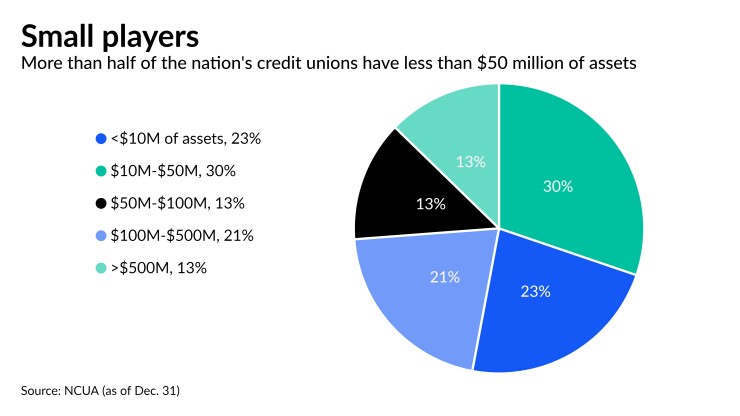Many credit unions are comfortable crossing $1 billion of assets — but few are in a hurry to surpass $10 billion.
Last year, 40 credit unions crossed over the smaller threshold, bringing the total institutions with at least $1 billion of assets to 370 on Dec. 31, according to the National Credit Union Administration. Only 16 credit unions had $10 billion of assets at the end of 2020.
While each level brings increased regulatory oversight, executives said the burden for reaching a seven-figure asset size is manageable in comparison to the benefits that come with more scale.
"We felt that the benefits of increased asset size and the associated resources provide a wider variety of opportunities for our membership," said Matt Kershaw, president and CEO of Clark County Credit Union in Las Vegas, which recently hit the

Increased size has allowed Clark County to select technology that helps set it apart from other lenders, while spreading the cost of any upgrades across a larger membership base.
"We think it is important to have a level of scale so that we can be competitive, but never forget that we serve a unique membership base that has different problems that require unique solutions," Kershaw said.
The credit union prepared for more oversight by creating a better system of controls to help executives manage the business risk that comes with having more members and loans. It included an evaluation of internal audit procedures and reporting, along with an evaluation of technology systems.
The biggest change that $1 billion-asset credit unions face is a required annual examination, compared to a three-year cycle for smaller institutions. An NCUA spokesman noted that some credit unions can quality for an 18-month exam cycle.
Industry data shows that reaching $1 billion of assets is a positive development for credit unions because it provides sufficient scale to compete in an "extremely competitive" environment, said Dennis Dollar, a credit union consultant and former NCUA board chairman.
The average return on average assets for credit unions with more than $1 billion of assets was 0.78% in the fourth quarter, surpassing the 0.61% mark for those with $500 million to $1 billion of assets, according to data compiled by the NCUA.
The loan-to-share ratios for credit unions with more than $1 billion of assets was 75.3% in the fourth quarter, slightly better than the 74.9% for those with $500 million to $1 billion of assets.
"I know of no credit union that shies away from the $1 billion mark,” Dollar said. “Every credit union I am aware of strives to get there safely, soundly and smartly over time.”
While the banking industry complains about the competitive advantage that big credit unions have, given their tax-exempt status, a limited number of executives seem intent to reach $10 billion of assets.
That’s because of the enhanced scrutiny that those credit unions face from the NCUA and state regulators, Dollar said. Credit unions with $10 billion or more of assets also face Consumer Financial Protection Bureau exams and caps on interchange fees.
The $10 billion threshold triggers an annual exam, capital planning and a stress test requirement, the NCUA spokesman said. The NCUA and CFPB
Crossing the larger threshold "requires strategic planning in advance,” Dollar said. “It requires a great deal more preparation and strategic consideration.”
To be sure, there are credit unions girding to make the jump.
Lake Michigan Credit Union in Grand Rapids ended the fourth quarter just shy of the threshold, and CEO Sandy Jelinski has spent recent years planning for crossing over it.
"It all comes down to efficiency and controlling expenses," Jelinski said. "We strive to offer the best value for our members and that means establishing processes and procedures that ensures we are efficient."
Credit unions gain a sense of status and are viewed by outsiders as being more successful as they get bigger, Jelinski said.
“This milestone helps create a positive image, especially among business owners," she said. "I believe it will help our mortgage business as well.”
As for heightened regulatory scrutiny, Jelinski said all the credit union wants is a fair shake.
"We’re just hoping for a fair and balanced approach” from regulators, she said.





